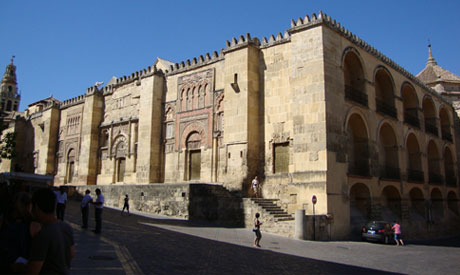
The Andalusian Legacy in Alexandria
Countless visitors to Alexandria, Egypt are unaware of the strong Andalusi cultural imprint that the city bears.
Throughout history, successive waves of Andalusi traveled from southern Spain to Egypt, some as pilgrims on their way to Mecca, some as students or travelers and some as refugees and exiles.
Among the most prominent names are Ibn Jubayr (traveling from Seville), Abu Hayyan (linguist from Granada) and Ibn Maymoun (physician and philosopher from Cordoba). In this series, however, we focus on three figures that left Al-Andalus and settled in and died in Alexandria and Egypt's Delta, leaving behind a legacy little known - and hence little celebrated - by Egyptians.
Their lives and works will be the subject of the coming three articles in the series, but first we touch on the historic and cultural contexts, taking the story back to where it all started.
In the year 711, Muslim troops under Tariq bin Ziyad crossed Al-Zuqaq (later known as the Strait of Gibraltar, which acquired its name from the Arabic Jebel Tariq) marking the beginning of an era of Islamic rule in the Iberian Peninsula that would last till the fall of Granada in 1492. The territory controlled by the Muslims at the time, known as Al-Andalus; reached its maximum splendor under the Umayyad Caliph Abd Al-Rahman III.
Over some eight centuries, Al-Andalus yielded extraordinary intellectuals, scientists and humanists: Averroes (Ibn Rushd), Ibn Al-Baitar, Ibn Tufayl and Avenzoar (Ibn Zuhr) are just a few names of global fame. They were Renaissance Men long before the European Renaissance, since most of them were polymaths of exceptional quality.
As Al-Andalus entered in contact with other parts of the Muslim World, many of these polymaths traveled as far to the east as the Levant and Egypt to seek knowledge or apprenticeship with learned men of the Orient. The cities of Kairouan, Cairo, Damascus and Baghdad were magnets that attracted the great minds of Al-Andalus - but it was not always a craving for knowledge that brought them. In many cases, it was the political situation that forced them out of Al-Andalus.
Rebels with a cause
In his book Al-Kamil fi Al-Tarikh, Ibn Al-Athir tells us about a failed rebellion that was staged in Cordoba and ended with the rebels being exiled to Fes and Alexandria. It was during the reign of the Umayyad Prince Hisham I (796-881) that the people in the neighbourhood of Sekunda in Cordoba staged a rebellion against the prince in 818CE, and the consequences were catastrophic: the rebels were massacred, the neighbourhood razed to the ground and survivors banished…something that led Ibn Hazm to describe Hisham I as "the most blood-thirsty Umayyad emir."
What happened next was something out of a fairytale. According to Al-Maqarri in his book Nafh Al-Tib, "the exiles that arrived in Alexandria eventually rebelled, took over the city and the angry Caliph (Al-Maamun) sent an army led by Abdullah ibn Taher to restore order. A deal was negotiated: the Cordoban exiles could keep their arms and belongings as long as they left Alexandria immediately. They did leave: destination Crete. Again, they managed to control (and govern) the island till it fell decades later. Not bad for a group of exiles!
A second wave of Andalusi immigrants came in the twelfth century as Al-Andalus came under the grip of radical Berber dynasties, namely the Almoravids and the Almohads. Averroes was banished to Marrakesh, while Maimonides, the Jewish intellectual, ended up in Cairo. An even more important wave came in the following century as the Reconquest gained momentum and Islam lost the cities of Cordoba, Seville and Valencia, among others. People felt scared, and while some went to Granada in the southeast, others crossed to Al-Maghreb (Morocco) and Egypt.
Probably the last wave was that which followed Felipe III's (1609) decree where over 300,000 moriscos (Muslims converted to Christianity under the pressure of the infamous Inquisition Courts) were expelled.
Why Alexandria
The logical question now would be: why did scores of Andalusi choose Alexandria and the Delta? Why travel clear across to the other end of the Mediterranean? The answer is threefold: First, while many immigrants settled in Moroccan, Algerian and Tunisian cities close to their homeland that they dreamed of going back to one day, others preferred to sail as far away as possible, lest the Christian armies should attack.
Second, many of these people came from coastal and harbour cities and they wanted something similar or at least close to the cities that they came from. Alexandria was a perfect choice, especially given its tolerant and multicultural character. Finally, some people believed that living in a harbour city subject to potential attacks (by the Byzantines or the Crusaders in the case of Alexandria) and being ready to defend it is a form of ribat, close to jihad. Furthermore, Alexandria and the Delta were noted as charming, with good-hearted people and rich culture, which added the final brushstrokes.
According to Dr Hossam Abdel Moati in his book Family and Wealth, the Andalusi presence in Alexandria during the Ottoman Period was centred around what we know today as the Turkish City. Important family names included Al-Quturi and Al-Hamrawi, among others. The presence extended to Rosetta, Damietta, Tanta and other cities.
So, what remains of the Andalusi legacy in Alexandria?
There is much richly impregnated in Alexandria, and Ahram Online will bring this to our readers in the coming articles as we follow the footsteps of Al-Mursi, Al-Turtusi and Al-Sustari.
Short link: